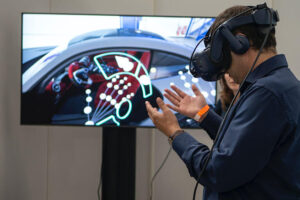 Since their inception, augmented reality and virtual reality have begun to be very actively introduced into the daily life of people and businesses.
Since their inception, augmented reality and virtual reality have begun to be very actively introduced into the daily life of people and businesses.
These technologies have sparked interest not only among smartphone users, but also among new and existing businesses, prompting entrepreneurs and marketers to consider investing in AR / VR app development. Technology has revolutionized the corporate sector in recent years. In the coming years, the development of AR / VR technologies will force every entrepreneur to turn to specialists and enter this field in order to get a large share of the expected profit.
At the end of 2020, the international immersive technology market was estimated at $ 6.1 billion. By 2025, virtual helmets are expected to be as widespread as smartphones are today.
Marketers study trends and incorporate them into their strategies. There are many trends, some are being replaced by others. But there are global trends – megatrends that change the lifestyle of people and affect business. Megatrends are interconnected and entail environmental, social and economic changes.
1. VR for In-Store Experience
With COVID-19 still wreaking havoc and the future seems uncertain, more and more ecommerce businesses will use Virtual Reality to draw in customers. Keep in mind that traditional stores attract customers by creating an alluring environment with dynamic product displays.
For online businesses, now is time to invest in VR and to close the gap between traditional stores and online shopping. This magical technology induces the social aspect of shopping in real-time.
With 3D products, customers can walk around the VR store, interact with friends, and even ask a virtual member of staff for support if necessary.
2. Virtual fitting
In 2022, progressive ecommerce projects will begin to very actively introduce virtual reality technologies, primarily such as virtual fitting.
Since now, and so most of the trading takes place online, this process will be even more comfortable for customers.
This will help customers with what they are buying. For example, augmented reality mirrors allow shoppers to “try on” desired clothes or shoes without actually wearing them.
While virtual fitting solutions are popular in clothing and footwear stores, they will now be available for furniture, makeup, glasses, and accessories.
3. Navigation in the online store
Augmented reality makes it easy for customers to take a tour of the mall and find exactly what they were looking for. In-store navigation based on augmented reality is mainly presented in the form of a mobile application. These apps use advanced programming language features like Python try-catch to provide users with much more than just AR routing.
AR-based apps can help shoppers find the best shopping route, show the exact location of a desired product, and even direct them to giveaways and discounts.
4. VR for houses and apartments
VR technology will play a key role in opening up the real estate industry. This allows potential home or apartment buyers to take a journey into the digital world. The best example is the Softengi real estate app.
This allows retailers to create accurate models of a house or apartment and invite shoppers to visit them virtually using a VR headset. The model is made from a house or apartment that is under construction and can be remodeled.
VR presupposes technological equipment both on the part of content producers and on the part of users, therefore the technology is not ubiquitous. Its counterpart is augmented reality, AR is more practical.
5. VR for in-store shopping
With customer behavior shifting towards online shopping, e-commerce businesses should consider investing in virtual reality to close the gap between traditional shopping and online shopping. With 3D products, customers can navigate the VR store, chat with friends, and even seek support from a virtual employee when needed.
6. Incorporation of AR/VR in education
Advanced VR and AR capabilities will help educators create engaging learning content and make the learning experience fun. This will increase the likelihood of distance learners learning in VR classrooms, ensuring they don’t miss out on the benefits of learning in a classroom setting.
7. AR in Healthcare
AR and VR have big goals for transforming and developing the global healthcare industry. The medical service is evolving at a tremendous pace in order to offer the patient the best possible care.
AR is one of the most recent innovations in augmented reality in healthcare. In fact, this industry is expected to be worth US $ 2.4 billion by 2026. AR is currently being used by medical practitioners to prepare for surgery. It is used by surgeons to draw up checklists and examinations of organs that need to be worked on.
8. VR in the travel sector
VR is becoming a very influential marketing tool. Therefore, travel companies are adopting VR technology as part of their marketing strategies.
This technology gives travel agencies, hotels and similar companies in the tourism sector more options to provide realistic interactions with the services they offer.
In addition, the COVID-19 pandemic has opened up opportunities for the development of VR tourism. VR can serve not only as a marketing ploy, but also as an “alternative travel”, while tourists are not yet free to travel. It is also predicted that virtual reality will play a vital role in the post-pandemic of the tourism sector.
9. Gaming with VR
The virtual reality software market owes 43% to the gaming sector. Therefore, it should come as no surprise that the gaming sector continues to invest heavily in the virtual reality market. In fact, VR gaming revenue is currently estimated at $ 1.1 billion and is expected to grow to $ 2.4 billion by 2024 (PwC, 2020).
With VR headsets like the Oculus Rift, gamers can experience 3D creatures in an advanced virtual environment. Thus, the struggle to implement the most advanced wearable and VR input devices is also becoming the focus of many VR developers.
10. Remote assistance via AR/VR
Remote assistance and collaboration will be made easier with AR / VR developments. With the new technology, technicians will be able to monitor problems on site in real time via their mobile phones or laptops. They will be able to explore everything and create the best solutions using VR and AR technologies.
In conclusion
Augmented reality and virtual reality provide real, measurable benefits for online brands, and their future trends are also brilliant.
While the trend still has room to develop, it is already yielding tangible results for brands online – from furniture and luxury goods to cars and more.
Needless to say, investing in AR and VR is now one of the most reliable ways to attract new customers, increase sales, reduce product returns, and increase customer loyalty.
Are you already implementing these technologies or are you planning to use them in your e-commerce business in the future?















